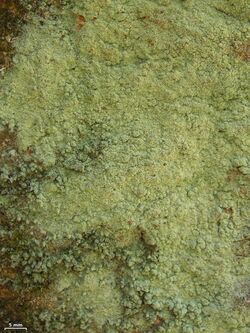Biology:Leprocaulaceae
| Leprocaulaceae | |
|---|---|

| |
| Leprocaulon knudsenii, San Gabriel Mountains, southern California | |
| Scientific classification | |
| Domain: | Eukaryota |
| Kingdom: | Fungi |
| Division: | Ascomycota |
| Class: | Lecanoromycetes |
| Order: | Leprocaulales Lendemer & B.P.Hodk. (2013) |
| Family: | Leprocaulaceae Lendemer & B.P.Hodk. (2013) |
| Type genus | |
| Leprocaulon Nyl. (1879)
| |
| Genera | |
Leprocaulaceae is a family of mostly lichen-forming fungi. It is the single family in the monotypic order Leprocaulales.[1] Leprocaulaceae contains three genera and about 33 species.
Taxonomy
Both the family and the order were circumscribed by American lichenologists James Lendemer and Brendan Hodkinson in 2013. They studied sterile, crustose lichens previously classified in the genus Lepraria using molecular phylogenetic techniques. They redefined the genus Leprocaulon to include several crustose lichens that were previously placed in Lepraria, and defined the new family and order to contain this genetically distinct grouping of species, including the genus Halecania.[2] Speerschneidera was included based on the results of a study published a year later.[3] The authors suggested that Leprocaulales is sister to the Caliciales,[2] although in a later phylogenetic study using a temporal approach, it appeared to be more closely related to the Teloschistales.[3]
Description
Collectively, Leprocaulaceae is a morphologically diverse family. Most taxa in the family are sterile lichens that reproduce asexually, and produce the secondary compounds argopsin, pannarin, and usnic acid. Those taxa that are fertile have lecanorine apothecia and hyaline ascospores.[2] Genus Halecania contains one lichenicolous fungus, and five lichenicolous lichens.[4]
Genera
- Halecania M.Mayrhofer (1987)[5] – 22 spp.
- Leprocaulon Nyl. (1879)[6] – ca. 10 spp.
- Speerschneidera Trevis. (1861)[7] – 1 sp.
References
- ↑ Wijayawardene, Nalin; Hyde, Kevin; Al-Ani, Laith Khalil Tawfeeq; Somayeh, Dolatabadi; Stadler, Marc; Haelewaters, Danny et al. (2020). "Outline of Fungi and fungus-like taxa". Mycosphere 11: 1060–1456. doi:10.5943/mycosphere/11/1/8.
- ↑ 2.0 2.1 2.2 Lendemer, James C.; Hodkinson, Brendan P. (2013). "A radical shift in the taxonomy of Lepraria s.l.: Molecular and morphological studies shed new light on the evolution of asexuality and lichen growth form diversification". Mycologia 105 (4): 994–1018. doi:10.3852/12-338.
- ↑ 3.0 3.1 Kraichak, Ekaphan; Huang, Jen-Pan; Nelsen, Matthew; Leavitt, Steven D.; Lumbsch, H. Thorsten (2018). "A revised classification of orders and families in the two major subclasses of Lecanoromycetes (Ascomycota) based on a temporal approach". Botanical Journal of the Linnean Society. doi:10.1093/botlinnean/boy060.
- ↑ Diederich, Paul; Lawrey, James D.; Ertz, Damien (2018). "The 2018 classification and checklist of lichenicolous fungi, with 2000 non-lichenized, obligately lichenicolous taxa". The Bryologist 121 (3): 340–425. doi:10.1639/0007-2745-121.3.340.
- ↑ Mayrhofer, Michaela (1987). "Studien über die saxicolen Arten der Flechtengattung Lecania in Europa I. Halecania gen. nov." (in de). Herzogia 7 (3–4): 381–406.
- ↑ Lamy, E. (1878). "Catalogue raisonné des lichens du Mont-Dore et de la Haute-Vienne" (in fr). Bulletin de la Société Botanique de France 25: 352. https://www.biodiversitylibrary.org/page/259822.
- ↑ Trevisan de St-Léon, V.B.A. (1861). "Über Atestia, eine neue Gattung der Ramalinaceen aus Mittelamerika" (in de). Flora (Regensburg) 44: 452. https://www.biodiversitylibrary.org/page/53502.
Wikidata ☰ Q21291459 entry
 |

